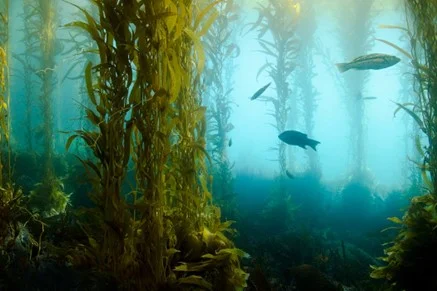Environment & Ecology
In News: Kelp forests are declining because of climate change as per the study published in the journal Nature 2023
- Kelp populations at equatorward-range edges are particularly vulnerable to climate change as these locations are undergoing warming at or beyond thermal tolerance thresholds
Kelp forests

- Kelp are large brown algae
- These are underwater ecosystems found in cool, nutrient rich, shallow waters that are close to the shore
- Many organisms use the thick blades as a safe shelter for their young from predators or even rough storms.
- Some kelp species can measure up to 150 feet (45 m) long. If living in ideal physical conditions, kelp can grow 18 inches (45 cm) a day.
- Sea urchins can destroy entire kelp forests at a rate of 30 feet (9 m) per month by moving in herds. Sea otters play a key role in stabilizing sea urchin populations so that kelp forests may thrive.
- Ecklonia radiata is the dominant and most widely distributed Laminarian kelp in the southern hemisphere
- New populations were found in shallower and cooler winter months with temperatures around 20°C
- Kelp can sometimes persist at lower latitudes, aided by cool water upwelling or in deep-water refugia where they are protected by thermocline (the transition layer between the warmer mixed water at the surface and the cooler deep water below)
Significance:
- Kelp forests provide food and shelter for thousands of species such as seals, sea lions, whales, sea otters, gulls, terns, snowy egrets, great blue herons, cormorants, and shore birds.
- Kelp forests provide underwater habitats to hundreds of species of invertebrates, fishes, and other algae and have great ecological and economic value.
- Loss of kelp forests will also lead to a decline of the unique biodiversity that they support
- There is high evolutionary diversity in the low-latitudes as many marine organisms were only able to persist within ice-free refuge areas at lower latitudes during the Ice Age
- Giant kelp is harvested from kelp forests and used as a binding agent in products like ice cream, cereal, ranch dressing, yogurt, toothpaste, lotion and more.
Threats
- The unique adaptive or evolutionary genetic diversity that the rear-edge populations (populations in warm, low-latitudes) may contain is also under threat due to rapid warming
Source DTE
Previous Year Question
Q1) Consider the following statements: (2018)
- Most of the world’s coral reefs are in tropical waters.
- More than one-third of the world’s coral reefs are located in the territories of Australia, Indonesia and Philippines.
- Coral reefs host far more number of animal phyla than those hosted by tropical rainforests.
Which of the statements given above is/are correct?
- 1 and 2 only
- 3 only
- 1 and 3 only
- 1, 2 and 3














